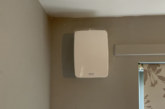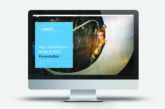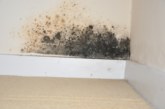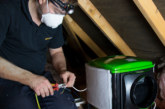Erlend Bolle discusses the dangers of radon and how local authorities can improve the indoor air quality of their building stock.
Awareness of radon gas and indoor air quality is becoming more and more common. As radon is the leading cause of lung cancer among non-smokers, local authorities are showing tenants that they care about their health and wellbeing by monitoring the indoor air.
We know that high levels of radon and other common air pollutants, such as volatile organic compounds (VOC) and carbon dioxide (CO2) buildup, can collect in schools, homes, offices, and public buildings. In fact, it’s all part of the air we breathe in every day. The problem is that they can accumulate in high levels in buildings of any type, size or location with occupants unaware of the potential danger as they’re difficult to detect.
Radon gas enters a building primarily because of the air pressure. The difference in pressure causes the building to act as a vacuum, drawing radon in through foundation cracks and other openings. It is at this point that radon can become trapped within the building and where the levels can start to build up to dangerous levels.
Research published earlier this year has found that energy efficiency improvements can impact radon levels and indoor air quality. While improvements are able to provide a benefit of warmer homes and energy savings, they often increase how airtight a building is. This can affect the fresh airflow into a building. Therefore, property owners and facility managers must be aware of the negative impact on air quality, as, without the correct ventilation, radon and other common indoor air pollutants can build up. The research suggests that changes should be coupled with radon and indoor air quality risk assessment and monitoring, to make sure radon levels stay low and indoor air stays healthy.

Monitoring air quality
The benefit of using an air quality monitor that includes radon as well as indoor air contaminants is the insights into trends and building health it provides. Armed with knowledge, local authorities can ensure their tenants are breathing in healthy and fresh air. This allows them to proactively detect any problems with the ventilation, which could affect radon, carbon dioxide, humidity levels and more.
They can use the data to optimise ventilation levels to be as cost-effective as possible, leading to savings on energy bills. Additionally, the data allows them to prioritise maintenance work and identify problems before tenants detect them, or to save them hours of investigation in the tenants’ property.

Considering the numerous factors of each individual property, many local authorities are being proactive in monitoring the air, however, there is still a long way to go. In the UK, radon is identified as a potential hazard in dwellings in the Housing Act 2004. Equipped with data and specific insights, property managers can identify air pollutants and contaminants, and take effective steps to improve the indoor air quality. Additionally, ensuring that the changes made to a property are positive, monitoring shows that they are invested in the wellbeing of the families living in the properties.
The only way to know whether elevated levels of radon are present is to use a device to monitor radon levels in the property, and long-term monitoring is by far the most accurate. Old-fashioned radon test kits based on charcoal or film canisters only provide a snapshot of radon levels (weeks-months), and need to be sent to a lab in order to get the results. Furthermore, they do not provide the necessary data to analyse temporal fluctuations and do not integrate with existing ventilation systems.
This is problematic as both pollutant and radon levels fluctuate significantly over time, and, as we have seen, there are numerous factors that impact air quality in each individual property. Additionally, they provide no insight into other factors of indoor air quality, which can really affect the health of a building and the people living in it. Comparatively, wireless, battery-operated air quality monitors allow a complete overview from one centralised location. This means that local authorities can access cloud-based data from all of their schools, nurseries and other buildings, online at any time.

Indoor environment
The issue of radon and indoor air quality continues to gain greater momentum as we have seen in government legislation such as the Housing Act of 2004. It is highly likely to become a UK requirement as public bodies and regulators focus on the matter. That is why it makes sense to reap the benefits sooner, rather than later.
With constant monitoring, property and facility managers can provide evidence to show that the improvements made to properties are working, adjust ventilation systems according to the requirement of the specific property, and show that the wellbeing of the occupants is a top priority.
Today’s solutions allow you to monitor radon and indoor air quality wirelessly via plug and play solutions. This means that facility managers do not need to rewire their buildings to take advantage of intelligent indoor air quality technology. Now is the time to take control of your indoor environment.
Erlend Bolle is Chief Product Officer at Airthings, which developed the first battery-powered digital radon detector allowing for constant and long-term monitoring of radon and indoor air quality via its Healthy Building Solution designed for facility and property managers.










